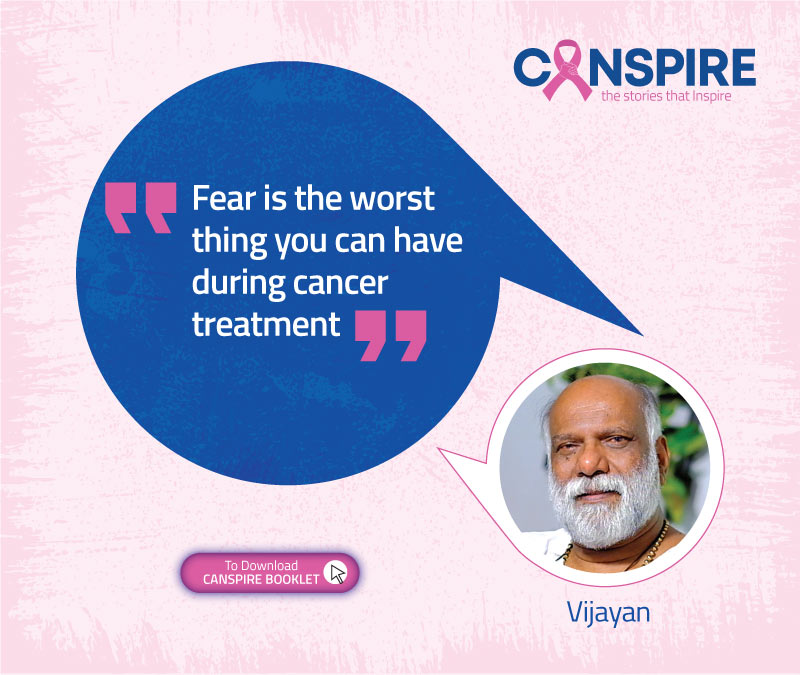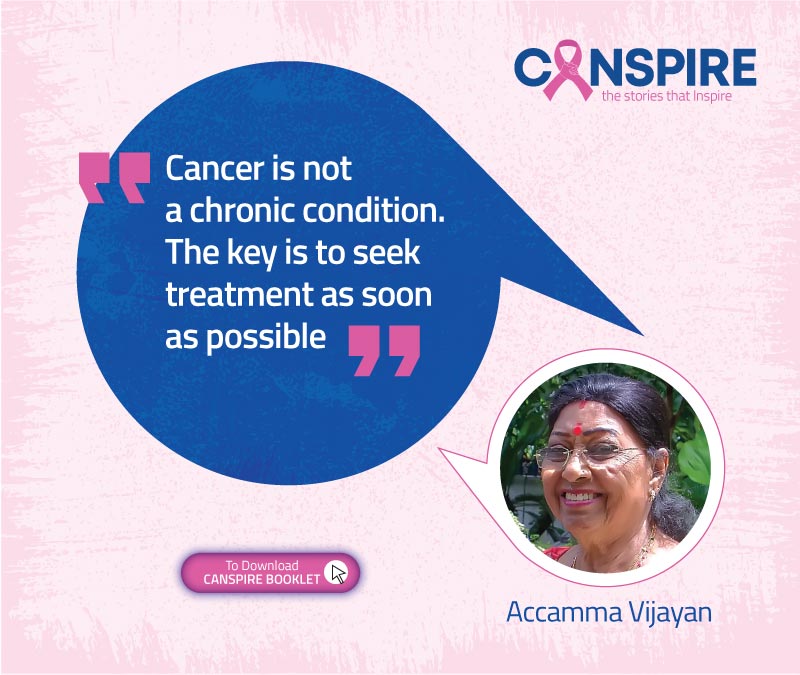CANSPIRE, the Aster Cancer Awareness Initiative, aims to create widespread awareness in the public. Cancer is probably the most dreaded disease in our society. Despite the number of success stories and fruitful medical advancements, we have not yet accepted it as a disease that can be entirely and most effectively treated. Owing to fear and misconceptions, many drop behind the diagnoses and even hesitate to seek treatment.
We must embrace it as a disease that can happen to anyone and try to find the "can" in cancer. The more we educate ourselves about cancer, spark conversations and familiarize ourselves with cancer treatment, the more we are the success. So, let's learn from the experience. Here are some of the most inspiring stories of cancer survivors from all walks of life; who have fearlessly fought cancer and came out victorious.
These stories prove that the human spirit is invincible and cancer is only a disease that can be treated. During challenging times of cancer diagnosis and treatment, these survivors can help you find perspective and courage. Whether you are facing a cancer diagnosis or coping after the diagnosis of a loved one, or simply want to understand the disease and help, these stories will guide you and enlighten you. This Canspire handbook is designed to help guide patients, family, and friends through the cancer experience. Let's stay united, and prove that we are stronger than cancer
Listen to the video series focuses on the experience during and after cancer treatment.
The cancer support groups at Aster Medcity were created with an intention of creating a rapport between the cancer survivors, who had undergone treatment Aster Medcity and the patients who are currently undergoing treatment for cancer at the hospital. These cancer support groups act as a platform for the cancer survivors and patients to share their experience in-between and in turn provides them with an emotional support during the curing process.
Our Support groups help to cope with cancer at every stage, as they navigate from treatment to recovery through the comprehensive and multimodal approach we offer. These unique support group comprises of clinicians, counsellors, dieticians and nurses offering voluntary support to all needy in their journey towards recovery.
Two of the active support groups in the hospital are Samasta and Sparsh. While Samasta is a general support group for all types of cancer patients and survivors, Sparsh is focused on children and their parents.
Together, we can be stronger than cancer. It is this belief that enables us deliver superior care at Aster Centre of Excellence in Oncology. Furthermore, to ensure the best possible patient outcomes we adopt an Integrated Cancer Care approach at all our hospitals in Kerala. Our multidisciplinary team is equipped to provide multimodal treatment options (Chemotherapy, Radiation, Surgery) under one roof at affordable cost. What more, with us you are better equipped to fight cancer.
Services
TELETHERAPY (EXTERNAL ) RADIATION
- Rapid arc treatment
- IMRT (Intensity modulated radiation therapy)
- IGRT (Image guided radiation therapy)
- Respiratory Gating
- Stereotactic Radiosurgery (SRS)
- Stereotactic Radiotherapy (SRT)
- Three dimensional conformal radiotherapy (3-DCRT)
- Electron radiation treatment
HDR -BRACHYTHERAPY TREATMENT
- Intra cavitary radiation
- Interstitial radiation
- Intraluminal radiation
REHABILITATION
Led by trained Physiatrist/ PM&R Physicians, the Physical Medicine and Rehabilitation Department at Aster Medcity offers advanced services for promoting mobility and functional ability lost due to injury or illness, by restoring the use of muscles, bones and the nervous system. The comprehensive therapy programmes here for pain management help enhance the ability to perform everyday tasks and improve one’s quality of life.
Facilities
- Allied Services
Counselling and patient education programmes Physiotherapy Occupational & Vocational therapy Rehabilitation Services Patient Assistance Program Patient Centric Clinical Research Community Outreach – early cancer screening centers through DM Foundation Health Camps
- Multi Disciplinary Tumor Board
Site specific disease management groups: Haemato oncology and BMT Neuro-Oncology, Orthopedic Oncology, Gastro Intestinal, hepatobiliary and pancreatic oncology group, Womens Cancer clinics Genito Urinary Oncology clinics Pediatric Oncology group Head and Neck oncology group Thoracic Oncology group.
- Minimal Access Robotic Surgery
Aster Medcity, for the first time in Kerala, introduces Robotic Surgery with da Vinci Robot- a highly advanced surgical Robot that performs minimally invasive surgeries with utmost precision. What can be called the next level in surgery, the da Vinci Robot has multi-limbed surgical robot with tiny wrists that bend in all directions, offering precision, dexterity and fine manipulation beyond that of human hand. The Surgeon performs minimally invasive surgeries by manipulating three robotic arms and a video camera that are inserted through small skin incisions, while seated in front of a computer console with 3D video screen and controls. The option of Robotic surgery is available in the Urology, Cardiothoracic, Gynaecology, Oncology, Gastroenterology, Bariatric and Paediatric Surgery Departments at Aster Medcity.
- Operation Theatres
ORI Fusion Digital Integrated Operation Theatres With 22 Operating Rooms that are on par with some of the largest in the world, Aster Medcity, for the first time South India, introduces ORI Fusion Digital Integrated Operation Theatres using Karlstorz OR1 Fusion - Asia Pacific’s first complete digital integration system.
The integration enables real-time sharing of images, videos and medical reports, which not only facilitates virtual participation from any location in the world but also helps the rest of the surgical team to monitor the patient closely during the operative procedure, much to the benefit and safety of the patient undergoing the surgery.
Aster Medcity is also the first surgical facility in the state to offer Robotic Surgery using a high-precision da Vinci Surgery Robot.
- Nuclear Medicine
PET-CT scanning, and Nuclear Medicine Therapy using Radio-pharmaceuticals like Iodine-131 PET –CT based radiotherapy planning.
- Imaging
CT scan based radiotherapy planning CT Simulator CT –MRI fusion Image based interventional ooncology (RFA , TACE)
- Cancer Screening
Early screening of cancers in the Breast, Cervix, Head and Neck, Colorectum, Prostate and Lung
















FREQUENTLY ASKED QUESTION
Prostate cancer begins when cells in the prostate gland start to grow out of control. The prostate is a gland found only in males. It makes some of the fluid that is part of semen.
The prostate is below the bladder (the hollow organ where urine is stored) and in front of the rectum (the last part of the intestines). Just behind the prostate are glands called seminal vesicles that make most of the fluid for semen. The urethra, which is the tube that carries urine and semen out of the body through the penis, goes through the center of the prostate.
What are the symptoms?
- Frequent urination
- Weak or interrupted urine flow, or the need to strain to empty the bladder
- The urge to urinate frequently at night
- Blood in the urine
- New onset of erectile dysfunction
- Pain or burning during urination, which is much less common
Who is most likely to get prostate cancer?
All men are at risk for prostate cancer. Out of every 100 men, about 13 will get prostate cancer during their lifetime. The most common risk factor is age. The older a man is, the greater the chance of getting prostate cancer.
Can you ever be cured of prostate cancer?
The short answer is yes, prostate cancer can be cured when detected and treated early. The vast majority of prostate cancer cases (more than 90 percent) are discovered in the early stages, making the tumors more likely to respond to treatment.
What is the main cause of prostate cancer?
Doctors know that prostate cancer begins when cells in the prostate develop changes in their DNA. A cell's DNA contains the instructions that tell a cell what to do. The changes tell the cells to grow and divide more rapidly than normal cells do. The abnormal cells continue living, when other cells would die.
Head and neck cancer is a general term used by doctors. It describes the diverse group of malignant tumors that can occur in the head and neck region.
What are the Symptoms?
- Mouth ulcer
- Lump in the neck, jaw, or mouth
- Pain or weakness in the face
- Neck pain
- Difficulty moving the jaw
- Difficulty swallowing
- Speech problems
- Ear pain or hearing loss
- Trouble breathing
- Sore throat
- White or red patches in the mouth or throat
- Weight loss
Who is at risk for head and neck cancer?
- People over the age of 40
- Poor oral and dental hygiene
- Poor care of the mouth and teeth may increase the risk of head and neck cancer
- Environmental or occupational inhalants
What does a cancerous lump in the neck feel like?
Cancerous lymph nodes can occur anywhere on the neck and are typically described as firm, painless, and sometimes may be immovable.
Can you feel cancer in your neck?
- A lump in the neck may be a sign of thyroid cancer, or it may be caused by an enlarged lymph node. Swelling in one or more lymph nodes in the neck is a common symptom of head and neck cancer, including mouth cancer and salivary gland cancer.
The female reproductive system performs several functions. The ovaries produce the egg cells, called the ova or oocytes. The oocytes are transported to the fallopian tube, where fertilization by a sperm may occur. The fertilized egg then moves to the uterus, where the uterine lining has thickened in response to the normal hormones of the reproductive cycle. Once in the uterus, the fertilized egg can implant into the thickened uterine lining and continue to develop. If implantation does not take place, the uterine lining is shed as menstrual flow. Also, the female reproductive system produces female sex hormones that maintain the reproductive cycle.
During menopause, the female reproductive system gradually stops making the female hormones necessary for the reproductive cycle to work. At this point, menstrual cycles can become irregular and eventually stop. One year after menstrual cycles cease, the woman is considered to be menopausal.
A. Uterine cancer:
What is uterine cancer?
Uterine cancer is a type of cancer that develops in the uterus. Most uterine cancer begins in the layer of cells that form the lining (endometrium) of the uterus. Risk factors include being overweight and starting periods at an early age.
What are the symptoms?
- Pain areas: in the pelvis
- Pain circumstances: can occur during sexual intercourse.
- Menstrual: abnormal menstruation, heavy menstruation, or irregular menstruation
- Also common: abnormal vaginal bleeding or weight loss
Does uterine cancer spread quickly?
The most common type of endometrial cancer grows slowly. It is most often is found only inside of the uterus. It grows more rapidly and tends to spread to other parts of the body.
How dangerous is uterus cancer?
If left untreated, endometrial cancer can spread to the bladder, rectum, vagina, fallopian tubes, ovaries, and many other distant organs as well. Fortunately, endometrial cancer grows slowly and, with regular checkups, is usually found before spreading very far.
What causes cancer of the uterus?
Although the exact causes of uterine cancers are not known, there are several risk factors. Common risk factors include women with endometrial overgrowth (hyperplasia), obesity, women who have never had children, menses beginning before age 12, menopause after age 55, estrogen therapy, radiation to the pelvis, and a family history of uterine cancer.
B. Cervical cancer
What is cervical cancer?
Cervical cancer is a type of cancer that develops in the cervix, the lower part of the uterus that connects to the vagina. Various strains of the human papillomavirus (HPV), a sexually transmitted infection, play a crucial role in causing most cervical cancer.
When exposed to HPV, the body's immune system typically prevents the virus from harming. However, in a small percentage of people, the virus survives for years, contributing to the process that causes some cervical cells to become cancer cells. You can reduce your risk of developing cervical cancer by having screening tests and receiving a vaccine that protects against HPV infection.
What are the symptoms?
It can be asymptomatic but people may also experience:
- Pain areas: in the pelvis
- Pain circumstances: can occur during sexual intercourse.
- Menstrual: abnormal menstruation, heavy menstruation, irregular menstruation, or spotting
- Groin: abnormal vaginal bleeding or abnormal vaginal discharge
- Also common: fatigue, nausea, or weight loss
How do you get cervical cancer?
All women are at risk for cervical cancer. It occurs most often in women over age 30. Long-lasting infection with certain types of human papillomavirus (HPV) is the leading cause of cervical cancer. HPV is a common virus that is passed from one person to another during sex.
At what age does cervical cancer occur?
Cervical cancer is most frequently diagnosed in women between the ages of 35 and 44. The average age of diagnosis is 50. It rarely develops in women younger than 20.
How do you beat cervical cancer?
- Cryosurgery- This treatment kills cancer cells by freezing them.
- Laser surgery- This treatment uses a laser to burn off cancer cells.
- Conization- It is also called a cone biopsy.
- Hysterectomy- A hysterectomy takes out the uterus and cervix.
C. Ovarian Cancer
Cancer begins in the female organs that produce eggs (ovaries).
Ovarian cancer often has no symptoms in the early stages. Later stages are associated with symptoms, but they can be non-specific, such as loss of appetite and weight loss. Surgery and chemotherapy are the most common treatment options.
What are the symptoms?
- Can have no symptoms, but people may experience:
- Pain areas: in the abdomen or pelvis
- Gastrointestinal: bloating, change in bowel habits, indigestion, or nausea
- Abdominal: abdominal fullness, fluid in the abdomen, or lump in the abdomen
- Whole-body: cancer-related fatigue or loss of appetite
- Also common: weight loss
What is the primary reason for ovarian cancer?
Inherited gene mutations are the leading cause of ovarian cancers. A small percentage of ovarian cancers are caused by gene mutations you inherit from your parents. The genes known to increase the risk of ovarian cancer are called breast cancer gene 1 (BRCA1) and breast cancer gene 2 (BRCA2). These genes also increase the risk of breast cancer.
Do you bleed with ovarian cancer?
Ovarian cancer is cancer in one or both of the ovaries. It is vital to know the signs and symptoms of ovarian cancer. These can include bloating, frequent urination (with no infection), back pain, heartburn, and pain during intercourse and unexplained bleeding.
How is ovarian cancer diagnosed?
- Transvaginal ultrasound (TVUS). TVUS is a type of imaging test that uses sound waves to detect tumors in the reproductive organs, including the ovaries.
- Abdominal and pelvic CT scan.
- A blood test to measure cancer antigen 125 (CA-125) levels.
- Biopsy.
Lymphoma is a cancer of the lymphatic system. It develops in lymphocytes, which are a type of white blood cell. These cells help fight disease in the body and play an essential role in the body’s immune defenses.
As this type of cancer is present in the lymph system, it can quickly metastasize, or spread, to different tissues and organs throughout the body. Lymphoma most often spreads to the liver, bone marrow, or lungs.
People of any age can develop lymphoma, but it is among the most common causes of cancer in children and young adults aged 15–24 years. It is often treatable.
What are the Symptoms?
The symptoms of lymphoma are similar to those of some viral diseases, such as the common cold. However, they typically continue for a more extended period.
Some people will not experience any symptoms. Others may notice a swelling of the lymph nodes. There are lymph nodes all around the body. Swelling often occurs in the neck, groin, abdomen, or armpits.
The swellings are often painless. They may become painful if the enlarged glands press on organs, bones, and other structures. Some people confuse lymphoma with back pain.
Lymph nodes can also swell during common infections, such as a cold. In lymphoma, the swelling does not resolve. Pain is also more likely to accompany the swelling if it has occurred due to an infection.
The overlap of symptoms can lead to misdiagnosis. Anyone who has persistently swollen glands should see their doctor for a consultation.
How long could you have lymphoma without knowing?
These grow so slowly that patients can live for many years mostly without symptoms, although some may experience pain from an enlarged lymph gland. After five to 10 years, low-grade disorders begin to progress rapidly to become aggressive or high-grade and produce more severe symptoms.
Can lymphoma be completely cured?
In a few cases, chemotherapy may be combined with steroid medication. Surgery isn't generally used to treat the condition, except for the biopsy used to diagnose it. Overall, treatment for Hodgkin lymphoma is highly effective and most people with the condition are eventually cured.
How is lymphoma detected early?
The best way to find lymphoma early is to pay attention to the possible signs and symptoms. One of the most common symptoms is enlargement of one or more lymph nodes, causing a lump or bump under the skin which is usually not painful. This is most often on the side of the neck, in the armpit, or in the groin.
Cancer of the lung, like all cancers, results from an abnormality in the body's basic unit of life, the cell. Normally, the body maintains a system of checks and balances on cell growth so that cells divide to produce new cells only when new cells are needed. Disruption of this system of checks and balances on cell growth results in an uncontrolled division and proliferation of cells that eventually forms a mass known as a tumor.
What are the symptoms?
Symptoms of lung cancer are varied depending upon where and how widespread the tumor is. Warning signs of lung cancer are not always present or easy to identify. Lung cancer may not cause pain or other symptoms in some cases. A person with lung cancer may have the following symptoms:
● Symptoms related to cancer:
The growth of cancer and invasion of lung tissues and surrounding tissue may interfere with breathing, leading to symptoms such as cough, shortness of breath, wheezing, chest pain, and coughing up blood (hemoptysis). If cancer has invaded nerves, it may cause shoulder pain or other difficulties. For example, if it has invaded the shoulder nerves, it may cause shoulder pain that travels down the outside of the arm (called Pancoast syndrome) or paralysis of the vocal cords leading to hoarseness. Invasion of the esophagus may lead to difficulty swallowing (dysphagia). If there is an obstruction of a large airway, collapse of a portion of the lung may occur and cause infections (abscesses, pneumonia) in the obstructed area.
● Symptoms related to metastasis:
Lung cancer that has spread to the bones may produce excruciating pain at the sites of bone involvement. Cancer that has spread to the brain may cause several neurologic symptoms that may include blurred vision, headaches, seizures, or cause symptoms of stroke such as weakness or loss of sensation in parts of the body.
Paraneoplastic symptoms: Symptoms that result from the production of hormone-like substances by the tumor cells frequently accompany lung cancers. These paraneoplastic syndromes occur most commonly with SCLC but may occur with any tumor type. A common paraneoplastic syndrome associated with SCLC is the production of a hormone called adrenocorticotropic hormone (ACTH) by the cancer cells. Subsequently, adrenal glands (Cushing's syndrome) produces excess cortisol hormone. The most frequent paraneoplastic syndrome seen with NSCLC is the generation of a substance similar to parathyroid hormone, resulting in a high level of calcium in the bloodstream.
● Nonspecific symptoms:
Nonspecific symptoms are seen with many cancers, including lung cancers, such as weight loss, weakness, and fatigue. Psychological symptoms like depression and mood changes also are common.
How does lung cancer start?
Lung cancer starts when abnormal cells grow out of control in the lung. They invade nearby tissues and form tumors. Lung cancer can start anywhere in the lungs and affect any part of the respiratory system. The cancer cells can spread, or metastasize, to the lymph nodes and other parts of the body.
At what stage is lung cancer usually diagnosed?
In most cases, patients first diagnosed with either type have stage IV disease. As their names suggest, these lung cancers are diagnosed when a pathologist identifies a specific type of diseased cell. Designating the type of lung cancer is the critical first step in understanding treatment options.
Can you have lung cancer for years and not know it?
Patients can (and usually do) live with lung cancer for many years before it becomes apparent. Early lung cancer is mostly asymptomatic. Internalization of tumors does not alert patients by visible physical changes.




















